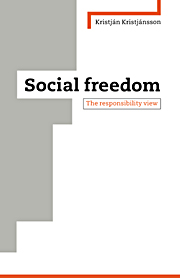Book contents
- Frontmatter
- Contents
- Acknowledgements
- 1 Introduction: freedom from Berlin onwards
- 2 Negative freedom: the nature of constraints
- 3 Obstacles and their weight
- 4 The test of moral responsibility
- 5 Internal bars and positive liberty
- 6 Freedom and power
- 7 Observations on method
- 8 Concluding remarks
- Bibliography
- Index
4 - The test of moral responsibility
Published online by Cambridge University Press: 31 March 2010
- Frontmatter
- Contents
- Acknowledgements
- 1 Introduction: freedom from Berlin onwards
- 2 Negative freedom: the nature of constraints
- 3 Obstacles and their weight
- 4 The test of moral responsibility
- 5 Internal bars and positive liberty
- 6 Freedom and power
- 7 Observations on method
- 8 Concluding remarks
- Bibliography
- Index
Summary
In chapter 2 I threw in my support for a responsibility view of negative freedom, possibly creating the impression that previous advocates of it had left little in this department for others to do. By contrast, much of chapter 3 was taken up by direct or indirect criticisms of their views: Benn and Weinstein's ‘ineligibility view’ of the necessary weight of obstacles was rejected, and, although Miller's analysis was deemed more acceptable, it also was found wanting in its appreciation of the concept of an obstacle. The present chapter will critically examine the accounts of moral responsibility’, given by these same writers, for that notion is obviously the cornerstone of any responsibility view of freedom.
To recap, a responsibility view of freedom is the view according to which an obstacle counts as a constraint on an agent's freedom if and only if there is another agent who can be held morally responsible for the existence of the obstacle. The latter agent may be responsible because he imposed the obstacle himself (deliberately or negligently), refrained from preventing its imposition by someone else, or failed to remove the obstacle after it had been created. (To avoid unnecessary repetition, I have coined the term ‘to suppress an obstacle’ for use in the sequel. Saying that an agent A suppresses an obstacle O shall be taken to mean that he refrains from imposing O, or prevents its imposition by others, or removes O if it has already been imposed.)
- Type
- Chapter
- Information
- Social FreedomThe Responsibility View, pp. 63 - 93Publisher: Cambridge University PressPrint publication year: 1996



